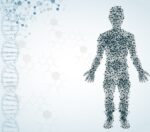Leptin Levels Linked to BMI, Not Motor Function in SMA 2 and 3
Serum levels not a 'useful marker' of disease severity in young people: study
Written by |

Levels of the hunger hormone leptin are not associated with motor function in children and adolescents with spinal muscular atrophy (SMA) types 2 and 3, according to a Serbian study.
Higher leptin was linked to a greater body mass index (BMI) — a surrogate marker of body fat — in the young patients, as it is in the general population.
“Serum leptin levels do not seem to be a useful marker of disease severity in children and adolescents with types 2 and 3 SMA,” the researchers wrote.
The study, “Serum leptin levels in children and adolescents with spinal muscular atrophy types 2 and 3,” was published in Archives de Pédiatres.
SMA is primarily known to affect the motor neurons, the nerve cells that communicate with muscles to control voluntary movement. Motor neuron loss leads to symptoms of muscle weakness and wasting seen to some degree in all SMA types.
However, accumulating evidence suggests SMA is a multisystem disorder that affects more than motor neurons alone. As such, there is growing interest in understanding the additional effects of SMA, including metabolic abnormalities.
Leptin is a hormone produced in the fat tissue involved in energy metabolism. From the bloodstream, it travels to a brain region called the hypothalamus, where it acts to suppress feeding behaviors and promote energy expenditure.
In the general population, higher blood leptin levels are associated with higher body fat and BMI (a ratio of weight to height). Age, sex, and pubertal status can also affect its levels.
A recent study showed that hyperleptinemia, or blood leptin levels higher than normal, was linked to lower motor function in young people with SMA types 1 to 3, suggesting it could be a marker of disease severity.
In addition, “hyperleptinemia was more frequent in underweight SMA patients,” suggesting a highly activated metabolism “and loss of appetite mediated by leptin may underlie weight loss,” the researchers wrote.
Leptin’s link to motor function, BMI in SMA youth
Researchers in Belgrade, Serbia set out to assess the potential link between blood leptin levels, motor function, and BMI in 37 children and adolescents, ages 2–19, with genetically confirmed SMA type 2 (22 patients) or type 3 (15 patients).
All were seen at a neuromuscular disorder referral center in Belgrade between July 2018 and July 2019. None were on disease-modifying treatments for SMA. The analysis was part of a larger study of heart and metabolic abnormalities in type 2 and type 3 pediatric patients.
Patients were divided into two groups: those who could sit, but not walk (“sitters”) and those who could walk (“walkers”).
Overall, 28 children were considered sitters, including all 22 of those with SMA type 2 and six with type 3 disease. The remaining nine pediatric patients with type 3 were able to walk.
The 28 sitters (11 boys, 17 girls) had a median age of 8.9, while walkers, comprised of five boys and four girls, had a median age of 8.
Blood leptin levels were highly variable across patients, with a median of 24.4 nanograms per milliliter (ng/mL) among sitters and 11.5 ng/mL among walkers.
After adjusting for potential influencing factors such as age and sex, the researchers found no significant association between leptin levels and motor function, as assessed with the validated Hammersmith Functional Motor Scale-Expanded (HFMSE).
Higher leptin levels were significantly linked to a greater BMI, however, as is typically observed in the general population.
“The lack of association between [blood] leptin levels and gross motor function in our patients with SMA might be explained by the fact that leptin reflects body fat rather than lean body mass (i.e., muscle mass),” the researchers wrote.
Consistent with that hypothesis, a study found that while body fat wasn’t linked to motor function in SMA type 2 patients, a weak association between lean body mass and HFMSE scores was observed.
The findings underscore that “[blood] leptin levels do not seem to be directly associated with disease severity in children and adolescents with types 2 and 3 SMA,” the research team wrote, noting that the absence of a comparator group of healthy children and adolescents limits the current study findings.
Still, “it would be a difficult task to find appropriate controls since SMA patients are frequently under- or overweight compared to their healthy peers and have altered body composition,” the researchers wrote.







